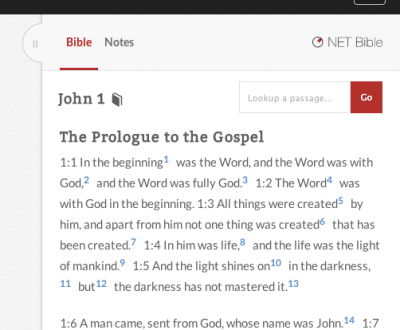The NET Bible in History
After a quick review of the history of the world, one could make the argument that whenever there is a new technological shift in the world which enhances communication, the Bible is often in the vanguard of literary works which make the jump to the new medium. One of the oldest devices for storing extensive stretches of the written word is the scroll. Jews used the scroll for thousands of years to contain the scriptures of the Hebrew Bible (many synagogues and temples still do), but scrolls can be unwieldy.
After a quick review of the history of the world, one could make the argument that whenever there is a new technological shift in the world which enhances communication, the Bible is often in the vanguard of literary works which make the jump to the new medium. One of the oldest devices for storing extensive stretches of the written word is the scroll. Jews used the scroll for thousands of years to contain the scriptures of the Hebrew Bible (many synagogues and temples still do), but scrolls can be unwieldy. It is difficult to find passages in them, and they are somewhat labor intensive to use. So along comes the codex, also known as the book. It was a stroke of genius to take the scroll apart into pieces of similar size, lay the pieces on top of one another, and bind them on one side. All of a sudden the same amount of text was more portable and usable. It is a matter of scholarly debate as to whether Christians invented the codex (such is the argument of C. H. Roberts and T. C. Skeat, but they are in the minority), but without doubt Christians certainly made wide use of it. The vast majority of New Testament manuscripts we possess are from books instead of scrolls. So along comes Johannes Gutenberg and his improved printing press. Up to this point most all books were written by hand. Printing as a process existed for quite a while prior to the 15th century, but it had not developed to the point where it was quick and efficient. With a stroke of genius Gutenberg constructed an improved printing press with metal moveable type some time prior to 1450; the first volume book printed on this improved press was the Gutenberg Bible printed around 1455. Now Bibles could be printed more quickly and efficiently than before. So along comes the internet. Mass-produced books are useful, but there are still production costs, materials to consider, and the raw fact of distribution. The internet mitigates all those factors, allowing for practically instant communication of the written word with almost zero incremental cost. On the internet I can distribute one copy of a text as easily, quickly, and cheaply as I can distribute a million (try doing that with a printed book without going broke). Enter the NET Bible. With a stroke of genius, Bible.org decided to leverage the internet for worldwide distribution of the Bible. It could be available online for free, forever, to anyone who had internet access. The NET Bible was conceived to meet this goal, and its continued development is simply continual progress on the same tracks. My interpretation of the NET Bible may be a bit lofty, to be sure, and just because Bible.org was the first translation with the internet in mind does not mean that we should sit still. As the internet now develops beyond simple text to social networking, minuscule devices, and to advances we can only dream of at present, Bible.org must continue to be at the tip of the vanguard with further development on Bible translation. But whenever you read the NET Bible remember that you are not reading just another translation. You are reading an important piece of history that marks a sea change in the way the Bible is translated and distributed to the world.

